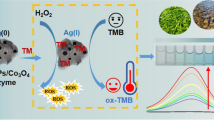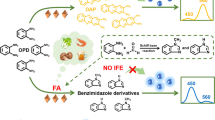Abstract
To improve the accuracy and specificity of visual sensors for detecting Cu(II) and Hg(II), a fluorescent and colorimetric dual-modal sensor based on Au nanoparticles (AuNPs) prepared by using carbon dots (CDs) was designed. If a sensor is to be applied for the detection of targets in different environmental backgrounds, it needs to have high stability against heat, pH, and salt. To this end, CD-wrapped AuNP probes were fabricated by the in situ reaction of chloroauric acid and reductive CDs. The reductive CDs were prepared with hyperbranched polyethyleneimine (HPEI) as a carbon source. HPEI-CDs not only acted as a reducing agent but also as an excellent stabilizer in the preparation and detection application of the AuNPs. Based on multiple signal responses, including color, UV-Vis absorption, and fluorescence intensity, the HPEI-CD/AuNP nanosensor was used to realize the detection of Cu2+ and Hg2+ in the linear range 9.0×10−10–9.0×10−4 M and 9.0×10−7–9.0×10−5 M with low detection limits of 75.6 nM and 281 nM, respectively. In tap water analysis, the recovery of Cu2+ and Hg2+ by fluorescent range from 109.98–113.31% and 100.65–100.81%, and the RSD values were 0.1159–1.6317% and 3.2–5.4%, respectively. The recovery of Cu2+ and Hg2+ by colorimetric detection were 99.72–100.14% and 99.88–100.12%, and RSD values were 0.6527–0.6842% and 0.4400–0.8386%, respectively. Importantly, this sensor was applied to the accurate and sensitive detection of Cu2+ and Hg2+ in tap water and sea water. The multimode readout nanosensor exhibited strong potential for achieving simultaneous detection of two different heavy metal ions in practical applications.
Graphical abstract
The novel multi-mode readout carbon dots/AuNPs sensor for Cu2+ and Hg2+ detectionshowed high sensitivity and selectivity.







Similar content being viewed by others
References
Pan Y-Q, Xu X, Zhang Y, Zhang Y, Dong W-K (2020) A highly sensitive and selective bis(salamo)-type fluorescent chemosensor for identification of Cu2+ and the continuous recognition of S2−, Arginine and Lysine. Spectrochimica Acta Part A: Mol Biomol Spectroscopy 229:117927
Qi Y, Ma J, Chen X, Xiu F-R, Chen Y, Lu Y (2020) Practical aptamer-based assay of heavy metal mercury ion in contaminated environmental samples: convenience and sensitivity. Analytical Bioanalytic Chem 412:439–448
Liu Y, Liu Y, Li Z, Liu J, Xu L, Liu X (2015) An unusual red-to-brown colorimetric sensing method for ultrasensitive silver(i) ion detection based on a non-aggregation of hyperbranched polyethylenimine derivative stabilized gold nanoparticles. Analyst 140:5335–5343
Zhou Y, Huang X, Hu X, Tong W, Leng Y, Xiong Y (2021) Recent advances in colorimetry/fluorimetry-based dual-modal sensing technologies. Biosens Bioelectron 190:113386
Baker SN, Baker GA (2010) Luminescent carbon nanodots: emergent nanolights. Angewandte Chemie Int Edition 49:6726–6744
Song H, Li Y, Shang L, Tang Z, Zhang T, Lu S (2020) Designed controllable nitrogen-doped carbon-dots-loaded MoP nanoparticles for boosting hydrogen evolution reaction in alkaline medium. Nano Energy 72:104730
Wang X, Cao L, Lu F, Meziani MJ, Li H, Qi G, Zhou B, Harruff BA, Kermarrec F, Sun YP (2009) Photoinduced electron transfers with carbon dots. Chem Commun (Camb):3774–3776
Wang F, Lu Y, Chen Y, Sun J, Liu Y (2018) Colorimetric nanosensor based on the aggregation of AuNP Triggered by carbon quantum dots for detection of Ag+ ions. ACS Sustain Chem Eng 6:3706–3713
Michalet X, Pinaud FF, Bentolila LA, Tsay JM, Doose S, Li JJ, Sundaresan G, Wu AM, Gambhir SS, Weiss S (2005) Quantum dots for live cells, in vivo imaging, and diagnostics. Science 307:538
Liu Y, Liu Y, Xu L, Li J, Liu X, Liu J, Li G (2017) Highly selective, colorimetric detection of Hg2+ based on three color changes of AuNPs solution from red through sandy beige to celandine green. Sens Actuators B: Chem 249:331–338
James G, Speight JS, JG Speight, Lange NA, Dean JA (2005) J.G. SpeightLange's Handbook of Chemistry 70th Anniversary Edition, McGraw-Hill Professional Publishing, New York.
Liu T, Dong JX, Liu SG, Li N, Lin SM, Fan YZ, Lei JL, Luo HQ, Li NB (2017) Carbon quantum dots prepared with polyethyleneimine as both reducing agent and stabilizer for synthesis of Ag/CQDs composite for Hg2+ ions detection. J Hazardous Mater 322:430–436
Dong Y, Wang R, Li G, Chen C, Chi Y, Chen G (2012) Polyamine-Functionalized carbon quantum dots as fluorescent probes for selective and sensitive detection of copper ions. Analytical Chem 84:6220–6224
Xu H, Yan L, Si J, Li X, Xu Y, Hou X (2020) Influence of the photoluminescence property of carbon nanodots on the reduction of silver ions. J Luminescence 217:116804
Siirilä J, Karesoja M, Pulkkinen P, Malho J-M, Tenhu H (2019) Soft poly(N-vinylcaprolactam) nanogels surface-decorated with AuNPs. Response to temperature, light, and RF-field. Eur Polymer J 115:59–69
Wang B, Zhou X-Q, Lin J-M, Liu S-Y, Lu C-H, Liu L-J, Chen Y, Yu L-P (2021) Concentration-modulated dual-excitation fluorescence of carbon dots used for ratiometric sensing of Fe3+. Microchem J 164:106028
Song Z, Quan F, Xu Y, Liu M, Cui L, Liu J (2016) Multifunctional N,S co-doped carbon quantum dots with pH- and thermo-dependent switchable fluorescent properties and highly selective detection of glutathione. Carbon 104:169–178
Gu T, Zou W, Gong F, Xia J, Chen C, Chen X (2018) A specific nanoprobe for cysteine based on nitrogen-rich fluorescent quantum dots combined with Cu2+. Biosens Bioelectron 100:79–84
Zhang R, Chen W (2014) Nitrogen-doped carbon quantum dots: facile synthesis and application as a “turn-off” fluorescent probe for detection of Hg2+ ions. Biosens Bioelectron 55:83–90
Zhou L, Lin Y, Huang Z, Ren J, Qu X (2012) Carbon nanodots as fluorescence probes for rapid, sensitive, and label-free detection of Hg2+ and biothiols in complex matrices. Chem Commun 48:1147–1149
Lakowicz JR (2006) Principles of Fluorescence Spectroscopy, third edn. Springer, New York
Peng C, Chai L, Tang C, Min X, Song Y, Duan C, Yu C (2017) Study on the mechanism of copper–ammonia complex decomposition in struvite formation process and enhanced ammonia and copper removal. J Environ Sci 51:222–233
Aazami J, KianiMehr N (2017) Survey of heavy metals in internal tissues of Great cormorant collected from southern wetlands of Caspian Sea, Iran. Environ Monit Assess 190:52
Hua C, Zhang WH, De Almeida SRM, Ciampi S, Gloria D, Liu G, Harper JB, Gooding JJ (2012) A novel route to copper(ii) detection using ‘click’ chemistry-induced aggregation of gold nanoparticles. Analyst 137:82–86
Yin B-C, Ye B-C, Tan W, Wang H, Xie C-C (2009) An Allosteric Dual-DNAzyme Unimolecular Probe for Colorimetric Detection of Copper(II). J Am Chem Soc 131:14624–14625
Kaur P, Sareen D, Singh K (2011) Selective colorimetric sensing of Cu2+ using triazolyl monoazo derivative. Talanta 83:1695–1700
Lin Z, Luo F, Dong T, Zheng L, Wang Y, Chi Y, Chen G (2012) Recyclable fluorescent gold nanocluster membrane for visual sensing of copper(ii) ion in aqueous solution. Analyst 137:2394–2399
Ding H, Liang C, Sun K, Wang H, Hiltunen JK, Chen Z, Shen J (2014) Dithiothreitol-capped fluorescent gold nanoclusters: an efficient probe for detection of copper(II) ions in aqueous solution. Biosens Bioelectron 59:216–220
Shen Q, Tang S, Li W, Nie Z, Liu Z, Huang Y, Yao S (2012) A novel DNA-templated click chemistry strategy for fluorescent detection of copper(ii) ions. Chem Commun 48:281–283
Yu Y, Yu C, Yin T, Ou S, Sun X, Wen X, Zhang L, Tang D, Yin X (2017) Functionalized poly (ionic liquid) as the support to construct a ratiometric electrochemical biosensor for the selective determination of copper ions in AD rats. Biosens Bioelectron 87:278–284
Ly NH, Seo C, Joo S-W (2016) Detection of Copper(II) Ions using glycine on hydrazine-adsorbed gold nanoparticles via Raman spectroscopy. Sensors 16:1785
Lin L, Wang D, Ye J-L, Lin M, Wang D-J, Yin G-D (2016) Oxadiazole-based selective chemosensor for copper (II) based on fluorescence quenching. Synthetic Metals 221:220–226
Chen X, Jou MJ, Lee H, Kou S, Lim J, Nam S-W, Park S, Kim K-M, Yoon J (2009) New fluorescent and colorimetric chemosensors bearing rhodamine and binaphthyl groups for the detection of Cu2+. Sens Actuators B: Chem 137:597–602
Liu Y, Xu L, Liu J, Liu X (2015) Simultaneous enrichment, separation and detection of mercury(ii) ions using cloud point extraction and colorimetric sensor based on thermoresponsive hyperbranched polymer–gold nanocomposite. Anal Methods 7:10151–10161
Zhang XY, Wang ZH, Yang L (2008) A highly selective and sensitive fluorescent chemosensor for Zn2+. Chin Chem Lett 19:1240–1243
Funding
This work was financially supported by the National Natural Science Foundation of China (52073134), the Natural Science Foundation of Shandong Province (ZR2019BB026, ZR2019MEM026) and the Yantai Key R&D Program (2017ZH058, 2020XDRH098).
Author information
Authors and Affiliations
Corresponding authors
Ethics declarations
Conflict of interest
The authors declare no competing interests.
Additional information
Publisher’s note
Springer Nature remains neutral with regard to jurisdictional claims in published maps and institutional affiliations.
Supplementary Information
ESM 1
(DOCX 44305 kb)
Rights and permissions
About this article
Cite this article
Li, Y., Tang, L., Zhu, C. et al. Fluorescent and colorimetric assay for determination of Cu(II) and Hg(II) using AuNPs reduced and wrapped by carbon dots. Microchim Acta 189, 10 (2022). https://doi.org/10.1007/s00604-021-05111-6
Received:
Accepted:
Published:
DOI: https://doi.org/10.1007/s00604-021-05111-6




